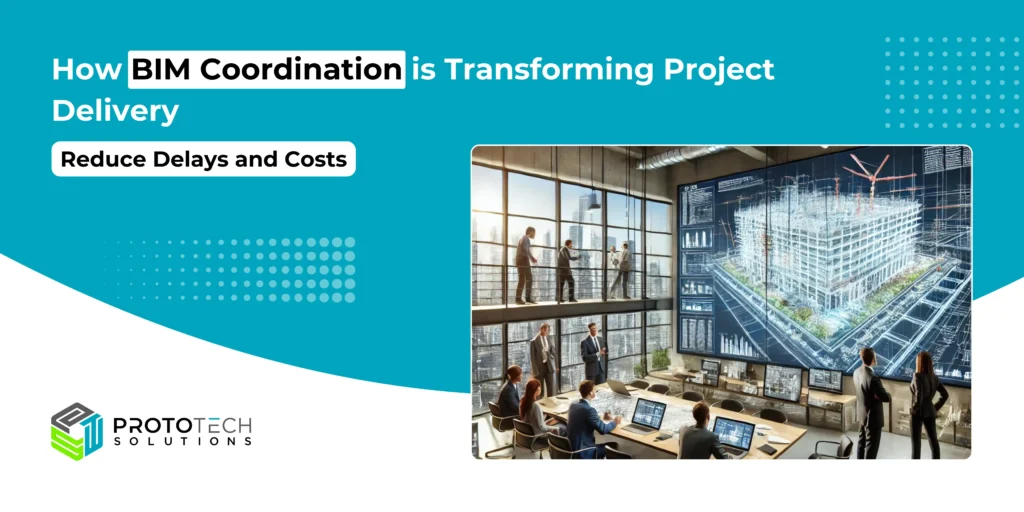How BIM Coordination is Transforming Project Delivery

In the fast-paced world of construction, efficiency is paramount. With projects growing in complexity and scope, managing timelines and costs has become an increasing challenge. Fortunately, Building Information Modeling (BIM) coordination is transforming how construction projects are delivered. This technology has already begun reshaping the industry by enhancing collaboration, improving project visualization, and ensuring better control over costs and schedules. As we look to the future, the continued evolution of BIM technology promises even more groundbreaking changes in construction project management, with the potential to reduce delays and costs further.
This blog post explores the key trends and benefits of BIM, highlighting its role in improving collaboration, efficiency, and sustainability in construction.
What is BIM Coordination?
BIM is a digital representation of the physical and functional characteristics of a facility. It provides a shared knowledge resource for information about a facility, forming a reliable basis for decisions during its life cycle. The essence of BIM lies in its ability to integrate various aspects of construction projects into a cohesive model that all stakeholders can access and manipulate.
BIM coordination refers to the collaborative process where all stakeholders, architects, engineers, contractors, and other professionals integrate their work into a single digital model. This coordination ensures that everyone involved in the project works from the same data set, reducing errors, conflicts, and misunderstandings.
By creating a virtual model of a building before construction begins, BIM enables project teams to anticipate problems, simulate various design and construction scenarios, and make informed decisions. This results in more accurate cost estimates, optimized schedules, and fewer unexpected issues during construction.
Why is BIM Coordination Important?
BIM coordination involves the process of managing and integrating various components of a construction project through a centralized digital model. This coordination is crucial for several reasons:
- Enhanced Communication: BIM serves as a single source of truth for all project stakeholders, reducing miscommunication and ensuring everyone is on the same page.
- Error Reduction: By visualizing the entire project in 3D, teams can identify potential conflicts before they arise on-site, significantly reducing costly rework.
- Streamlined Processes: BIM allows for better planning and sequencing of construction activities, leading to more efficient workflows.
The Impact of BIM on Project Delivery
BIM coordination has already made significant strides in improving the efficiency and success of construction projects. Here are a few key ways it has transformed the industry:
1. Enhanced Collaboration and Communication
One of the most significant advantages of BIM is its ability to foster seamless collaboration among architects, engineers, contractors, and owners. With real-time access to project data, stakeholders can easily share updates, resolve conflicts, and make informed decisions together. This centralized approach streamlines communication and ensures that everyone works with the same information, reducing misunderstandings and errors.
2. Streamlined Design and Construction Processes
BIM enables the creation of detailed 3D models that represent every aspect of a project. This visual simulation helps identify clashes or conflicts between building components early in the design phase. As changes are made to one aspect of the model, related elements automatically update, facilitating smoother design iterations. The result is a more efficient construction process with fewer delays.
3. Integration with Emerging Technologies
The future of BIM will see greater integration with emerging technologies such as the Internet of Things (IoT), Artificial Intelligence (AI), and Augmented Reality (AR). For instance:
- IoT Integration: IoT devices can monitor building performance in real time, providing valuable data that informs decision-making and proactive maintenance.
- AI Optimization: AI algorithms can analyze data from BIM models to optimize designs and automate routine tasks.
- AR Visualization: AR tools can overlay BIM models onto physical environments, enhancing understanding among project teams.
4. Increased Emphasis on Sustainability
As environmental concerns grow, the construction industry must prioritize sustainability. BIM plays a critical role in this shift by enabling more sustainable design and construction practices. For example:
- Energy Efficiency: BIM allows for simulations that assess energy consumption patterns, helping teams design buildings that minimize energy use.
- Material Optimization: By providing accurate quantity take-offs and material schedules, BIM helps reduce waste during construction.
Future Trends in BIM Coordination
1. Cloud-Based Collaboration
Cloud technology is revolutionizing how construction teams collaborate. With cloud-based BIM solutions, stakeholders can access project data from anywhere at any time. This flexibility enhances real-time collaboration and ensures that all team members are working with the most up-to-date information.
2. Automation in BIM Processes
The adoption of automation within BIM processes is expected to rise significantly. Automation can streamline tasks such as clash detection and quantity take-offs, allowing teams to focus on more complex aspects of their projects. This trend promises to enhance productivity and accuracy in project delivery.
3. Digital Twins
The concept of Digital Twins virtual replicas of physical assets—is gaining traction in construction. By utilizing Digital Twin technology alongside BIM, project teams can simulate, analyze, and optimize building performance throughout its lifecycle. This capability leads to more informed decision-making and improved project outcomes.
4. Regulatory Mandates
Governments worldwide are increasingly recognizing the potential of BIM to enhance project outcomes. As a result, regulatory mandates requiring the adoption of BIM technologies are becoming more prevalent across various sectors within the construction industry. These mandates aim to standardize practices and foster collaboration among stakeholders.
Challenges Ahead
Despite its many advantages, several challenges remain in fully realizing the potential of BIM:
- Skill Shortages: There is a notable shortage of skilled professionals who are knowledgeable about BIM technologies. Addressing this gap through training and education will be essential for widespread adoption.
- Initial Costs: Implementing BIM systems can require a significant upfront investment in software and training.
- Resistance to Change: Many construction companies still rely on traditional methods; shifting to a digital-first approach may face resistance from stakeholders accustomed to legacy systems.
Do you have a BIM project? Looking for a trusted BIM outsourcing company to take your projects to the next level? Look no further than ProtoTech Solutions.
With expertise in a wide range of BIM services, including BIM coordination, BIM modeling, Scan to BIM, Revit family creation, clash detection, CAD to Revit, CAD to BIM, CAD conversion, BIM structural analysis, 4D/5D construction simulation, and much more, ProtoTech Solutions is the ideal partner for optimizing your AEC project workflow and achieving exceptional results.
Conclusion
The future of construction is undoubtedly intertwined with Building Information Modeling (BIM) coordination. As this technology continues to evolve and integrate with emerging innovations, it promises to transform project delivery by enhancing collaboration, streamlining processes, and promoting sustainability. While challenges exist, the benefits far outweigh them as the industry moves towards more efficient and effective construction practices.
By embracing these changes today, stakeholders across the construction landscape can prepare for a future where projects are delivered faster, more accurately, and with greater environmental responsibility ultimately leading to better outcomes for all involved.






